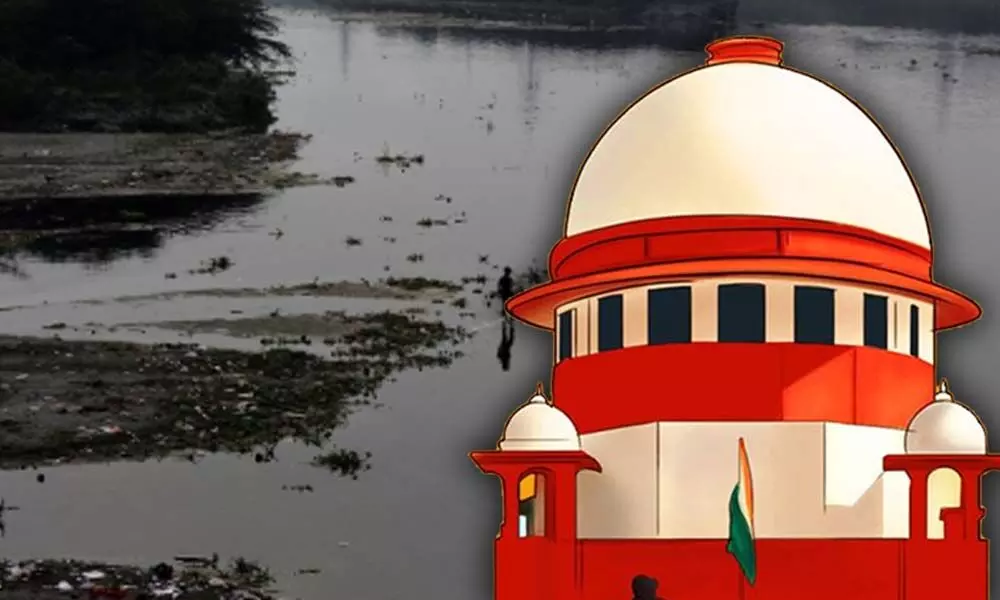Live
- Philippines orders full evacuation amid possible volcanic re-eruption
- Government Prioritizes Welfare of the Poor, says Dola Sri Bala Veeranjaneyaswamy
- Two Russian oil tankers with 29 on board damaged due to bad weather
- Telangana's Traditions Will Be Protected, Village by Village : BRS Leader MLC K. Kavitha
- Uganda to relocate 5,000 households from landslide-prone areas in eastern region
- Harish Rao Criticizes CM Revanth Reddy: "His Time is Over"
- Vijay Sethupathi Hails 'Vidudala-2' as a Theatrical Game-Changer
- Sahaj Yog: A Path to Inner Transformation and Harmony City takes giant strides
- Allu Arjun meets his uncle Nagababu at his residence
- J&K L-G felicitates Langar organisations & NGOs for contribution during Amarnath Yatra
Just In
At 2,562 MLD, Delhi has highest gap in sewage treatment capacity, SC told


At 2,562 MLD, Delhi has highest gap in sewage treatment capacity, SC told
Delhi's decades-long fight against pollution in the Yamuna river seems to have no end in sight soon.
New Delhi: Delhi's decades-long fight against pollution in the Yamuna river seems to have no end in sight soon. The Central Pollution Control Board (CPCB) in an affidavit has informed the Supreme Court that among several municipalities along the river, Delhi Jal Board (DJB) has the worst gap in sewage treatment and the water in Delhi has the highest level of Biochemical Oxygen Demand (BOD).
The affidavit filed by Nalin Kumar Gupta, scientist at CPCB, said: "in case of Delhi, the sewage generation is 3,273 million litres per day (MLD) and total installed/operational capacity of the 35 STPs is 2,715 MLD. However, actual utilisation is only 2,432 MLD of which 711 MLD is complying to discharge norms, thereby gap in sewage treatment capacity in case of Delhi is 2,562 MLD (3,273 MLD-711 MLD)." As per the data, there are 70 municipalities located along Yamuna river and 156 drains are discharging into the river.
The data from the state-wise list of municipalities having gaps in sewage treatment reveal that Delhi has gap of 2,562 MLD, followed by Prayagraj at 224.29 MLD and Faridabad at 220 MLD . In comparison with Delhi, the sewage treatment gap in many municipalities is extremely low, for example Nagar Nigam Agra (125.35 MLD), Nagar Nigam Agra (118 MLD), Nagar Nigam Saharanpur (89.5 MLD), Nagar Nigam Firozabad (72 MLD), Nagar Palika Parishad Muzaffarnagar (54.5 MLD), UPJN Ghaziabad (42.32 MLD). In 41 municipalities the gap in sewage treatment is below 10 MLD.
The data also reveals that Delhi's water quality has highest BOD at 114 followed by Faridabad and Ghaziabad at 59.0. For Gurugram, Sonepat, Rohtak, Beri municipal corporations the water had 57 BOD. The water in nearly 15 municipalities has BOD below 10.
According to sources in CPCB, high BOD establishes that water has worst pollution level and along with high level of gap in sewage treatment, it is kind of a worrying situation.
The response from CPCB came following the top court's order on January 13 asking it to submit a report identifying municipalities along the Yamuna river which have not installed total treatment plants for sewage as per the requirement or have gaps in ensuring that the sewage is not discharged untreated into the river.
The CPCB on January 15 requested state pollution control boards of Uttar Pradesh, Haryana, Himachal Pradesh, Uttarakhand and Delhi Pollution Control Committee, to provide municipality-wise latest information on sewage generation, treatment capacity and other prominent sources of contamination in the catchment of Yamuna river. Later, it collated the data and found DJB has the highest level of gap in sewage treatment in all the municipalities along Yamuna.
The affidavit said water quality data of drains depict that 100 drains in the catchment of Yamuna river (2 in Himachal Pradesh, 52 in Uttar Pradesh, 20 in Delhi, 26 in Haryana) are not meeting general standards for discharge of environment pollutants in respect of one or more parameters, namely, BOD (Biochemical Oxygen Demand), COD (Chemical Oxygen Demand) and TSS (Total Suspended Solids)."
In the top court, the Delhi Jal Board (DJB) had cited its inability to supply water to all areas of Delhi due to the high ammonia level in the river which enters Delhi from water coming from the Haryana side.
The DJB counsel had contended before the top court that the sewage treatment plant (STP) in Haryana was not working properly, which has led to a high ammonia level in the water, making it unfit for drinking. Haryana government had denied DJB claims, instead stressed the issues associated with pollution is at Delhi's end.
On January 13, the Supreme Court had said pollution-free water forms the basic right under the Constitutional framework and took suo moto cognisance on the issue of contamination of rivers by sewage effluents.

© 2024 Hyderabad Media House Limited/The Hans India. All rights reserved. Powered by hocalwire.com






